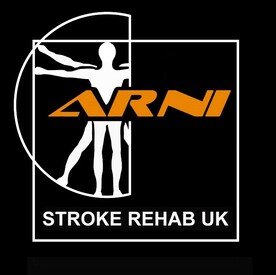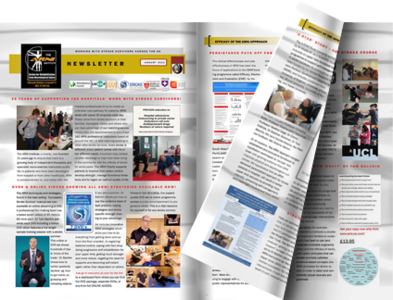Speakability is the national charity offering information and support to people with Aphasia, however caused. It was founded as ‘Action for Dysphasic Adults’ in 1979 by Diana Law who had personal experience of Aphasia. The charity runs a Helpline and Information Service, campaigns for greater understanding of Aphasia and better services and empowers people with Aphasia through its national network of Self-Help Groups.
News
Contact ARNI for Home Based Rehab with a Qualified Instructor
We are on Facebook
PLEASE HELP ARNI STROKE REHAB UK & DONATE A LITTLE THIS XMAS! THANK YOU!! - ... See MoreSee Less
For anyone navigating the journey of stroke recovery, the fear of a fall is often one of the biggest hurdles to regaining independence. The Kami Fall Detect Camera is a revolutionary smart home device designed specifically to act as a 'virtual guardian' for those at risk of falling. Unlike traditional pendant alarms that someone might forget to wear or be unable to press during an emergency, this camera uses advanced Artificial Intelligence to automatically 'see' when a fall happens.
The technology behind it is truly impressive because it doesn't just record video; it understands human movement. When the AI detects a fall, it immediately sends an alert to a caregiver or family member’s smartphone, allowing for a rapid response. For a stroke survivor, this means the end of worrying about being stuck on the floor unable to call for help. It even features two-way audio, so a loved one can speak through the camera to provide reassurance while help is on the way. Privacy is also a top priority, as the system can be set to protect the user's dignity while still ensuring they are monitored safely.
This is a fantastic, cost-effective solution for families in the UK. The Kami Fall Detect Camera currently retails for approximately £99, which is a small price to pay for such significant peace of mind. Best of all, there are no mandatory monthly subscription fees for the basic fall detection alerts, making it much more affordable than many traditional telecare systems.
If you're looking to add this extra layer of safety to your home or a loved one's house, you can easily purchase it in the UK through major online retailers like Amazon UK or directly via the Kami Home website. It is a simple but powerful way to help survivors stand tall and live more independently on their road to recovery! 🚶♂️✨🙏
www.arni.uk.com
#ARNIStrokeRehab #StrokeRecovery #KamiHome #FallDetection #IndependentLiving #SafetyFirst #StrokeSurvivor #SmartHomeTech #PeaceOfMind #RehabTools
... See MoreSee Less

Traditional exercise focuses on making your muscles stronger; the goal of rehab exercise is on connecting the brain to the body through movement.
Your brain relearns skills by rewiring itself through neuroplasticity, which is activated through rehab exercise. The more you practice rehab exercise, the more your brain rewires itself, and the more movement you recover.
If you need some help with your recovery then call us on 0203 053 0111 or email support@arni.uk.com. We have trainers throughout the country who can help you.
www.arni.uk.com
#arnistrokecharity #strokerecovery #ARNIstrokerehab #neurorehab #neuroplasticity #strokesurvivors #neurorehabilitation #strokesurvivorscan #strokeexercise #strokerehab #strokerehabilitation
... See MoreSee Less

mailchi.mp/arni/please-help-arni-stroke-rehab-uk-donate-a-little-this-xmas-thank-you ... See MoreSee Less
Please be generous today to your favourite Stroke Rehab Charity, Especially if you;ve enjoyed reading posts and interacting with ARNI staff - please help the Charity this Xmas time ! We REALLY need your help. We rely purely on kind donations... thank you! Happy Christmas from Dr Tom Balchin and staff at ARNI! PLEASE DONATE VIA PAYPAL BUTTON AT arni.uk.com/support-us/ ... See MoreSee Less

Thank you so much everyone @followers @top fans of ARNI Stroke Rehab & Recovery ! Especially those who have never given to ARNI Charity before 😉 Please donate via the button at arni.uk.com/support-us/
The core is the group of trunk and hip muscles that surround the spine, abdominal viscera and hip.
Why should you do core exercises? They are essential for improving balance, reducing your risk of falling, and improving your gait (manner of walking) and even your posture.
If you're not sure what you need to do then give us a call on 0203 053 0111 or email support@arni.uk.com to find out if there's an instructor near you who can help you.
www.arn#strokerecoveryk#strokesurvivorscanr#strokeexercisek#neuroplasticityp#neurorehabn#strokerehabt#strokerehabilitationb#neurorehabilitationb#strokerecoveryexercisesy#exerciseafterstrokefterstroke
... See MoreSee Less

A message for every stroke survivor.
www.arni.uk.com
#strokesurvivorscan #neurorehab #neurorehabilitation #strokesurvivors #arnistrokecharity #neuroplasticity #ARNIstrokerehab #strokeexercise
... See MoreSee Less

Try to do MORE with your more-affected upper limb by yourself each day (ie work towards a new goal, and check retention during your ADLs constantly afterwards (because you can lose ability, just like strength ; which is shockingly easy to lose). Repeated attempts to use your affected limbs in training creates a form of practice that can potentially lead to further improvement in performance. The ideal is to find oneself in a ‘virtuous circle’, in which spontaneous limb use and motor performance will reinforce each other and re-teach your body to control the position of an affected limb.
To find out if there's an ARNI trainer near you who can help you call 0203 053 0111 or email support@arni.uk.com
If you like this post then please share it with others. Each time that you share a post, you can directly help other people – as who knows which people in the world might find us and gain, either directly from the charity or simply by being able to copy an ‘innovative and useful’ move/trick of the trade that might help them manage after stroke.
Every time you share, you could directly help someone – as knowledge is power 😉
www.arni.uk.com
#neurorehabilitation #strokeexercise #strokesurvivorscan #neurorehab #exerciseafterstroke #strokerecovery #neuroplasticity #strokerehab #strokerecoveryexercises #strokerehabilitation
... See MoreSee Less

Please be generous today to your favourite Stroke Rehab Charity! We REALLY need your help. We rely purely on kind donations... thank you! Happy Christmas from Dr Tom Balchin and staff at ARNI! PLEASE DONATE VIA PAYPAL BUTTON AT arni.uk.com/support-us/ ... See MoreSee Less

Thank you so much everyone @followers @top fans of ARNI Stroke Rehab & Recovery ! Especially those who have never given to ARNI Charity before 😉 Please donate via the button at arni.uk.com/support-us/
Donated 😊
ARNI Stroke Rehab & Recovery what’s your , office phone number??? I thought I had it saved on my phone…. But, haven’t ( must’ve dreamt it!!!) as you suggested to keep in touch to see if there are any trainers in my area? … but, unfortunately I cannot contact you! Please send me phone numbers etc?? Kind regards j Perez
I'm spreading the word as a post stroke survivor not 5yrsvgonr we need to get the word out more,thanks Arnie x
After stroke, you will probably experience problems with trying to recover your balance (your ability to control your body without movement against gravity) and stability (your ability to control your body during movement). If this sounds like you then read this article to find out more.
www.arni.uk.com
#strokesurvivorscan #strokerehabilitation #strokeexercise #neuroplasticity #strokerehab #strokerecovery #neurorehab #neurorehabilitation #strokerecoveryexercises #exerciseafterstroke
... See MoreSee Less

HOW TO REGAIN BALANCE AFTER STROKE | ARNI
arni.uk.com
After stroke, you will probably experience problems with trying to recover your balance (your ability to control your body without movement against gravity) and stability (your ability to control your...
